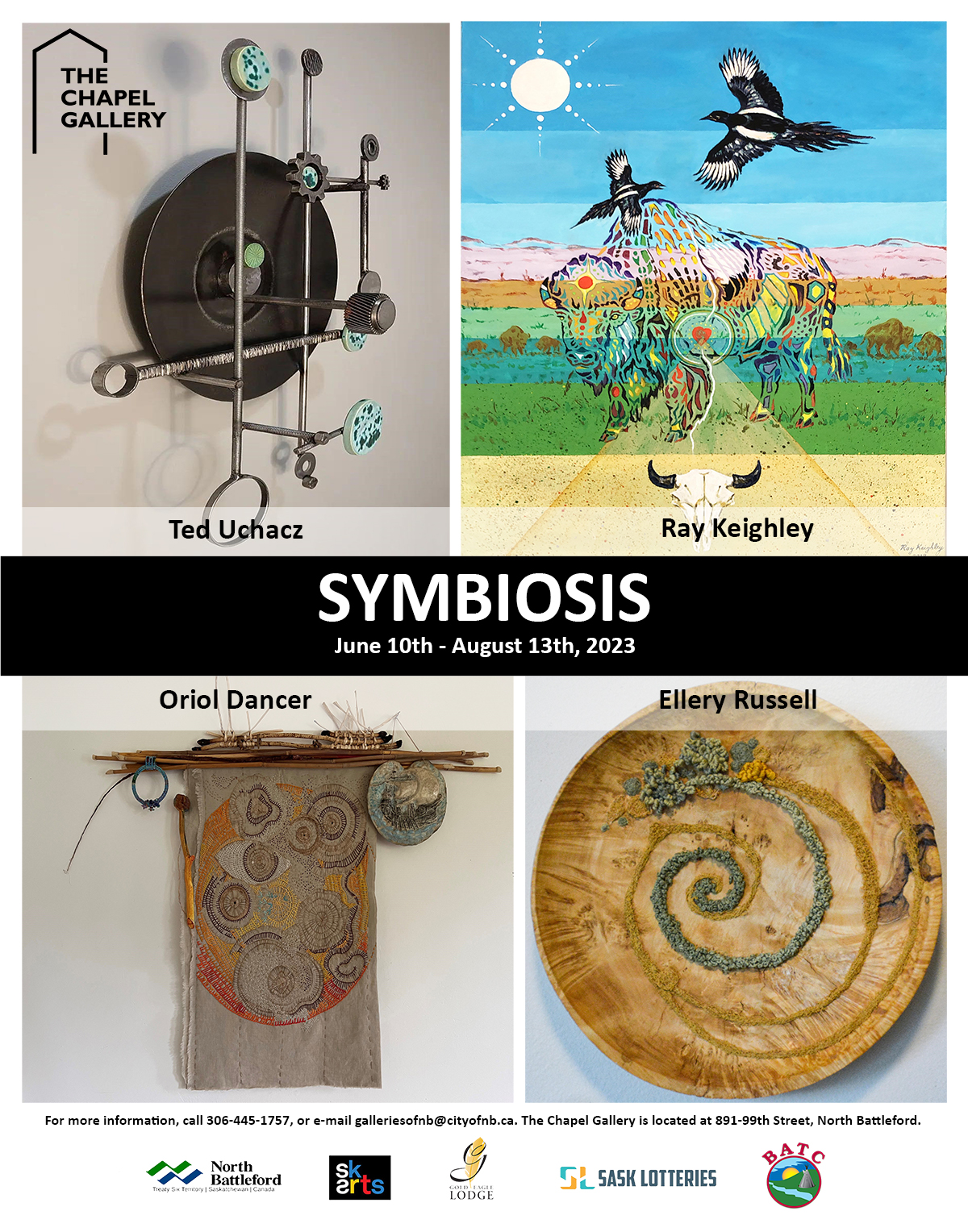MAIN GALLERY 2024
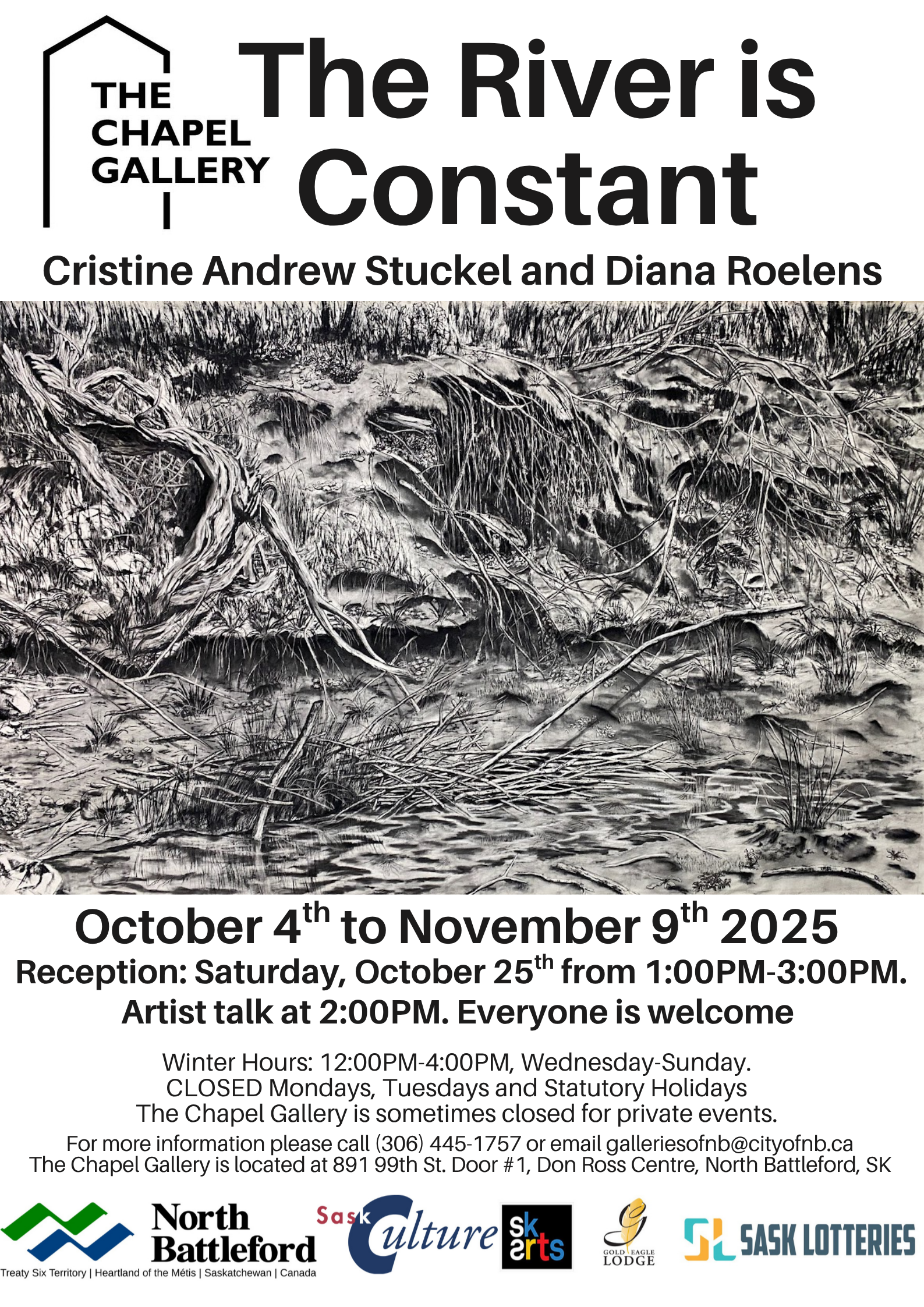
The River is Constant
Cristine Andrews Stuckel and Diana Roelens
October 4th - November 9th, 2025
The River is Constant - Artist Statement: "The River is Constant" is an exhibition of large-scale, immersive drawings by collaborative artist team Cristine Andrew Stuckel and Diana Roelens that situates the North Saskatchewan River as a steadfast and enduring feature of the Battlefords region in Saskatchewan. We began collaborating in the final years of the BFA program at the University of Saskatchewan. Our earliest collaborartive experiments immediately deviated from the notion of landscape as overview - wide open expanses or far-reaching vistas - and instead focued on the multifaceted intricacies that overwhelmingly exist in the immediate foreground of more intimate spaces. Broken branches, twigs, rocks, leaves and other detritus become the mountains, lakes, and forests of traditional landscapes; positioning these features as major focal points in our work elevates the status of these often over-looked elements of the natural world. We are immersed within the sublime and need not look to distant horizons. In our largest work to date, "The River is Constant", provides a backdrop for the artists' rendering of an ever-changing river valley - changes that are reflected and reinforced by the artists' techniques. Using a series of reference photographs from North Battleford, Battleford, Finlayson Island, and the surrounding river valley, the artists re-imagine the forested areas. Each feature in the drawings - trees- rocks, grasses, and shrubs - is reconfigured into a new arrangements while the river flows quietly in the background as it has for millennia. The inclusion of manmade features considers the symbiotic relationship between the natural phenomena of the area and its human inhabitants, achieving mutual sustainability only through respectful cooperation, a process mimicked by the collaborative approach of the artists. A detailed investigation of the riverbank in Riverwalk revealing the impact of river currents throughout the ages - altered landscapes, soil erosion, and the adaption of vegetation to changing conditions. Remnants of human incursion, though subtle, are evidenced through the fragments of an old battered pier with its decaying timber pilings and crumbling concrete, a bridge reflected in the still waters, and felled trees bleached white from exposure to the elements. A more recent human intervention, precast concrete riprap, which seeks to mitigate erosion and provide stability on steeper sections of the riverbank, appears as a feature in both drawings. The use of charcoal as a medium enables a versatile range of marks and lends itself to dramatizing the ineterplay of light and shadow; its physicality facilitate a sense of immediacy with the intense range of blacks, greyes, and whites that it produces. That charcoal is an organic material derived from trees added an additional layer of significance to its use in this work. The goal of "The River is Constant" i to cultivate new ways of seeing and encourage the viewer to go out and focus on the minutiae that exists in the tangled chaos of untamed spaces; it seeks to instill an appreciation of art in its most natural form." Cristine Andrew Stuckel and Diana Roelens.
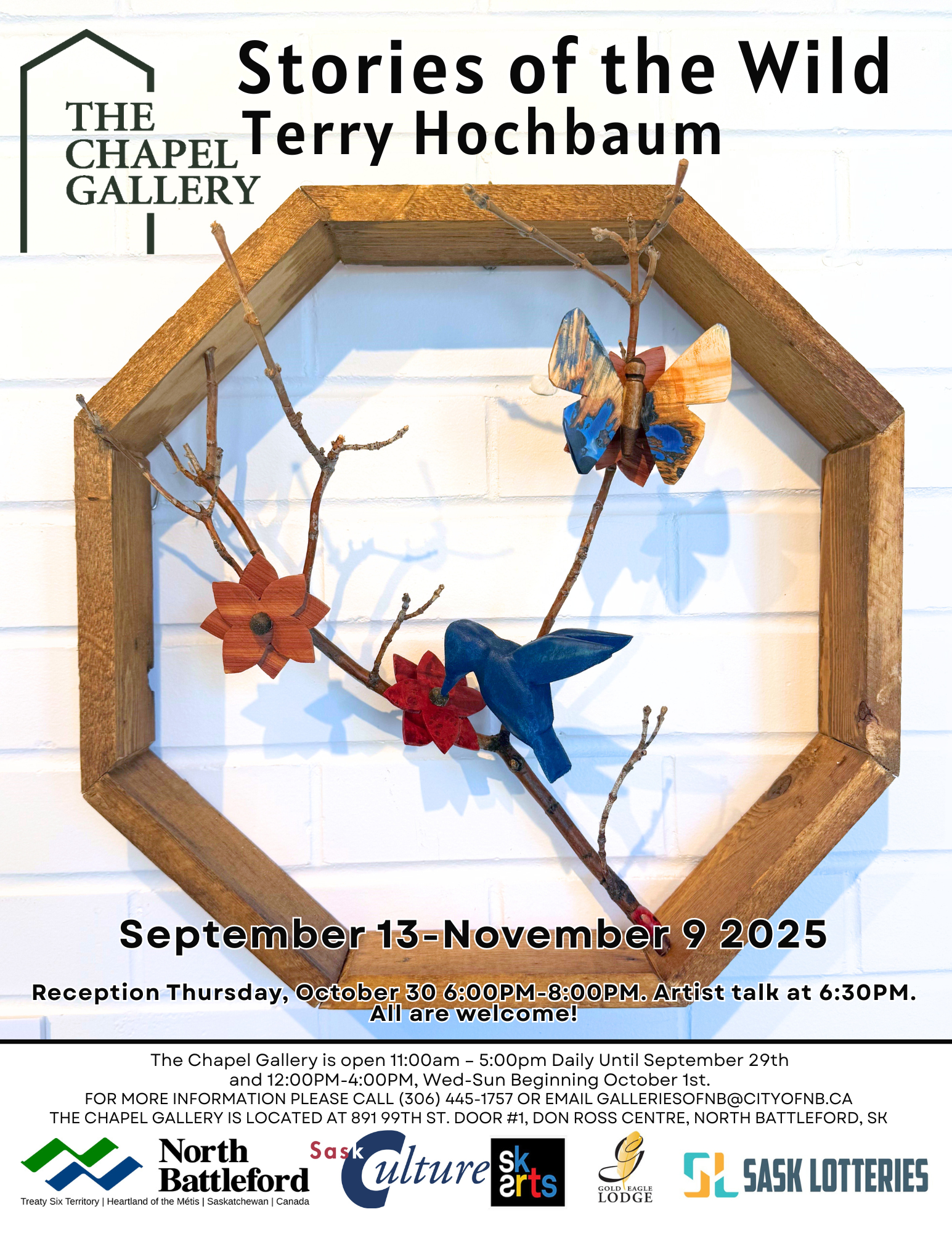
Stories of the Wild
Terry Hochbaum
September 13 - November 9th, 2025
"I was born in Wilkie Saskatchewan where we farmed just north of it. As I was growing up, I liked doing things with my hands. Wilkie had a gret shop and arts program, that taught a lot of basics in a variety of things, which still come in handy today. My first real hobby was knife-making. Firstly, I fooled around with wood projects. About a year and a half ago a little wood chickadee inspired me to try carving one and I never looked back and went full steam ahead.
Since buying a book and some tools, I am now learning how to carve, learning as I go and loving the challenges of the medium and the changes that occur. I am always looking to carve something different, wanting to brinng the art element into the carving." Terry Hochbaum
Loss, Lost, and Longing: Journey from Disease and Decay to Moving Forward
Linda Mushka
July 21 - August 31, 2025
Four years ago, my husband was diagnosed with cancer and was dead in less than a year. The first year I was in shock, the second consumed with writing through my grief and in the third worked on a series of fabric works exploring the process of what I had been going through for the past three years. I began by tea dying small scraps of fabric; cotton, linens and silks. I used both black and matcha tea. I also rust dyed some larger pieces.
I travelled to Vancouver Island for four months during the winter of 23/24 and decided to take small pieces to work on. While there, the forest was inspiration for both decay and regrowth. It is abundant in examples of the cycle of death and rebirth. Literally uprooted from all that is familiar, physically and psychologically, I explore these themes in the twenty or so pieces of this show. I have also utilized some swatches of commercial fabric and cork stabilized with cheesecloth. My journey wanders from the dark, flimsy veils that spell disaster, through uprootedness, to the nurse stumps which spur new growth, to cocooning and hunkering down with the trees close around, finally able to raise my eyes to look up and out and beginning to see a path through.
This show is a visual journey of the process of grieving the loss of my husband of fourty years, and the moving forward that is left for the living. I believe it is one all of us can relate to as death and transformation is a constant in this life. I am grateful to share these pieces with all of you. - Linda Mushka
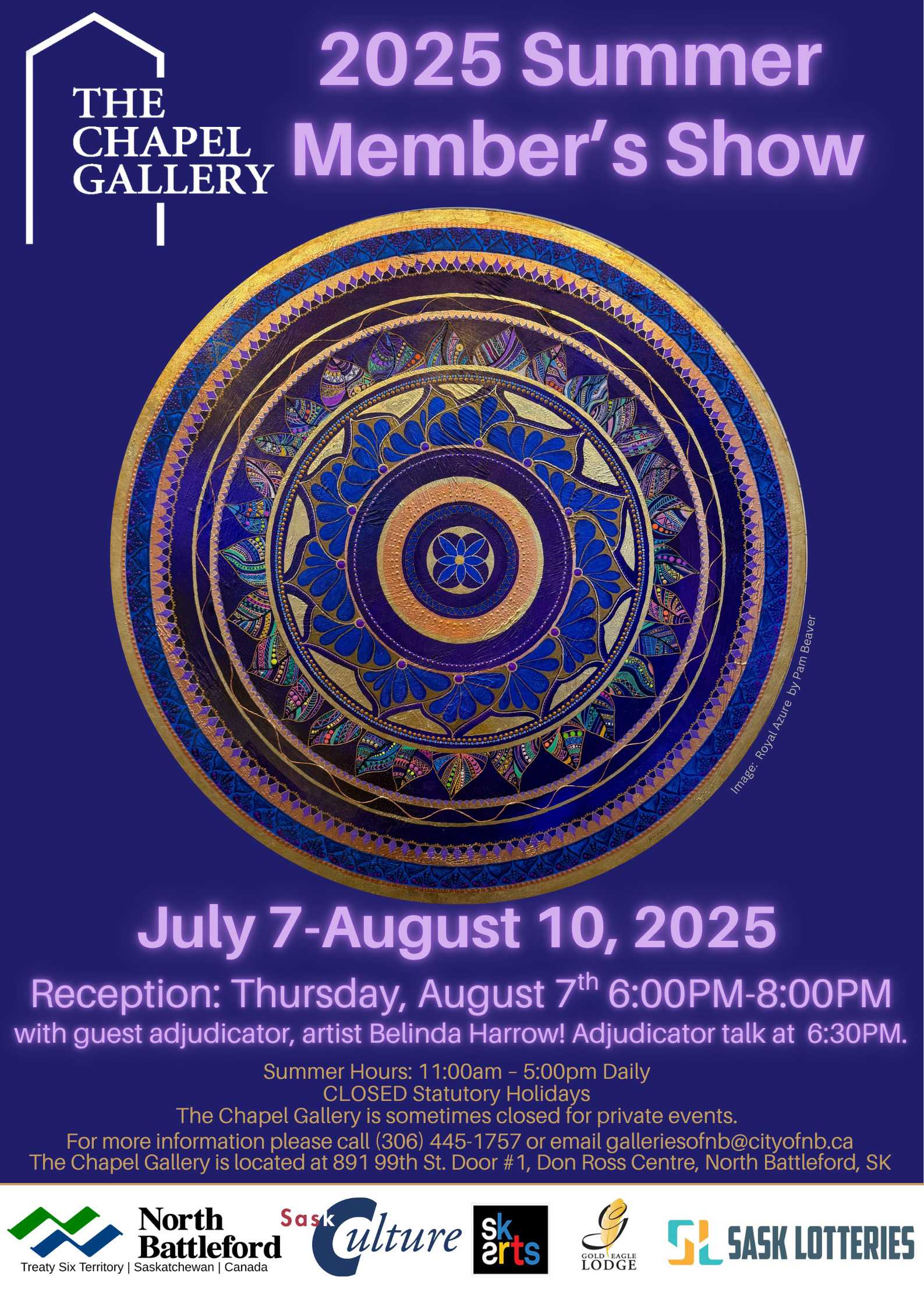
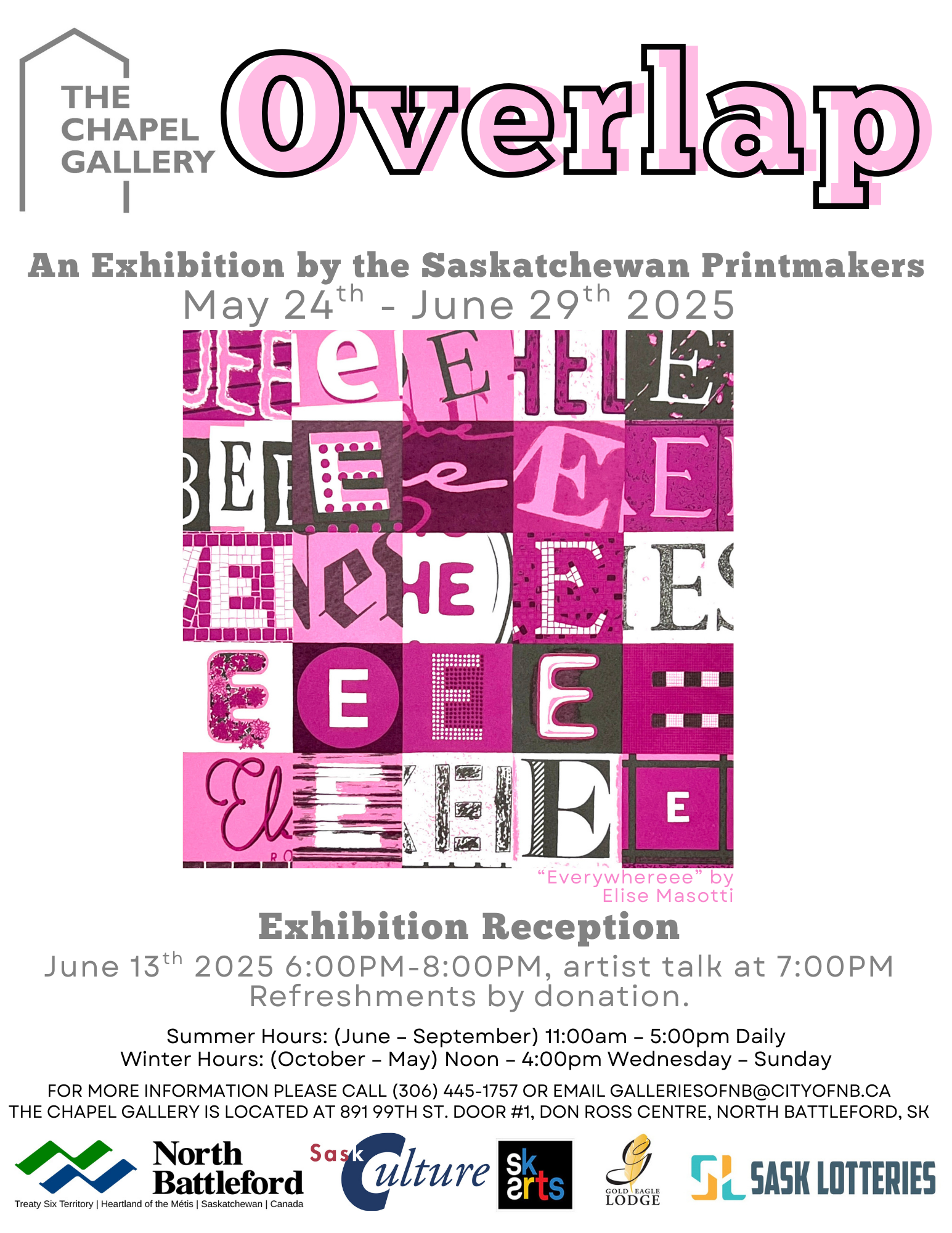
Overlap - SK Printmakers
May 24 - June 29, 2025
Overlap is an exhibition of various types of printmaking by members of the Sask Printmakers.
Overlap was chosen as the title for the exhibition as printmaking is a process of overlapping colour over colour, shape over shape, image over image and idea over idea. Printmaking is an exacting process yet one with many options. The overlap of ideas and concepts in artwork is an interesting one, often ideas are influence on what is happening in the world around the artist at the time of printing.
The overlapping of shape can create an illusion of depth or with the use of transparent ink, it can create a while new colour.
Printmaking also has a generational overlap as many of the presses and equipment used in printmaking has been passed down generation to generation.
Saskatchewan Printmakers is a volunteer- run, not-for-profit that exists province-wide to provide print artists at any stage in their career exhibition and networking opportuniites. This member-based organization aims to connect artists working in print medial across the province and country. The organization hosts monthly meetings and invites printmakers from other provinces and countries to share their process and prints.

Apples and Train Tracks - Arnolda Dufour Bowes
March 1 - April 13th, 2025
Arnolda Dufour Bowes reclaimed pieces of her father's Road Allowance home, still standing in Punnichy, and repurposed them into unique pieces of art. Many of her pieces tie a connection to the land and culture. Along with her compositions of poetry, attendees will have the privilege to enjoy a short narration film written and directed by Arnolda, and narrated by Basil Quewezance. Plus, original artwork by artist Andrea Haughian.
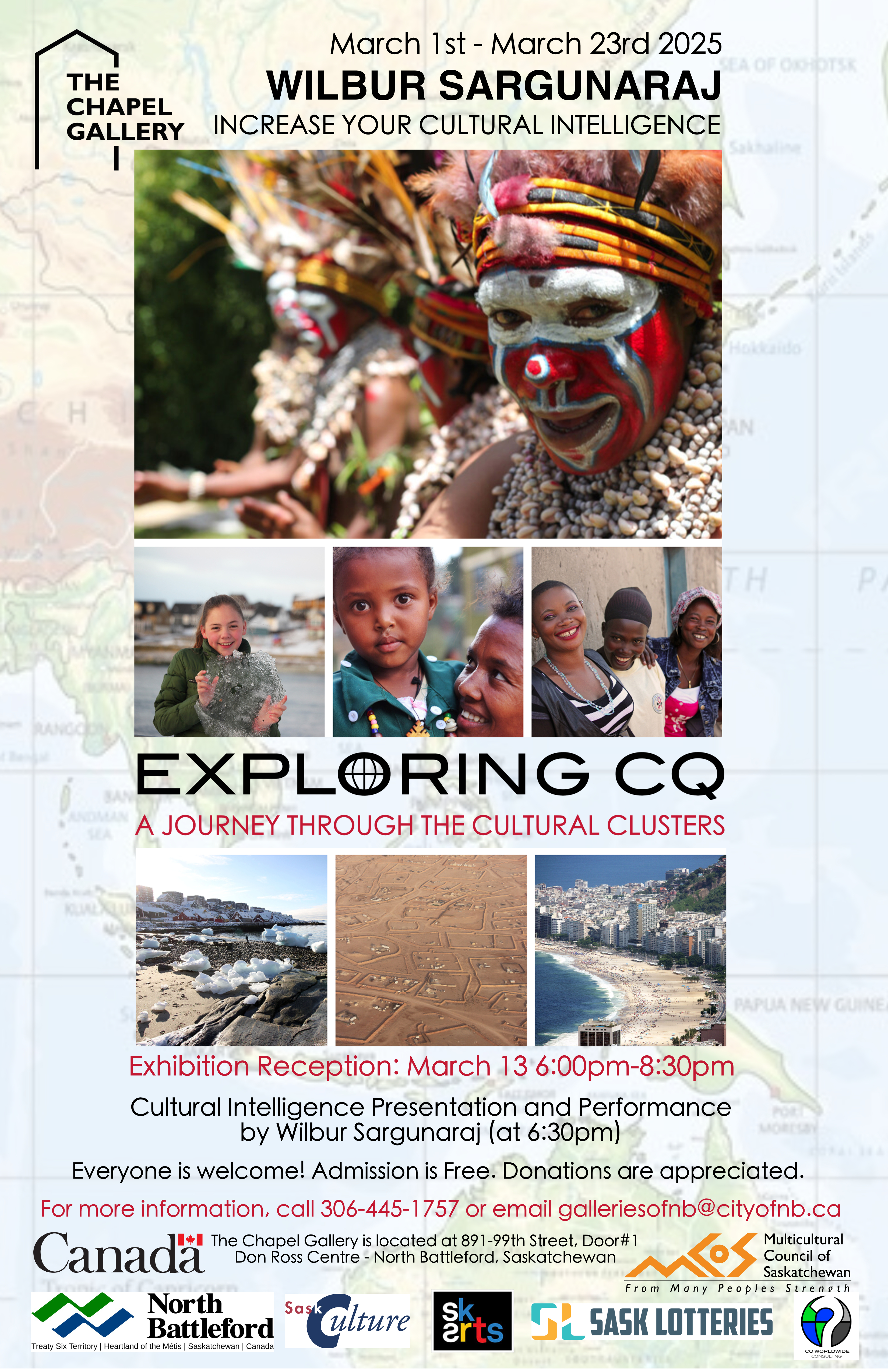
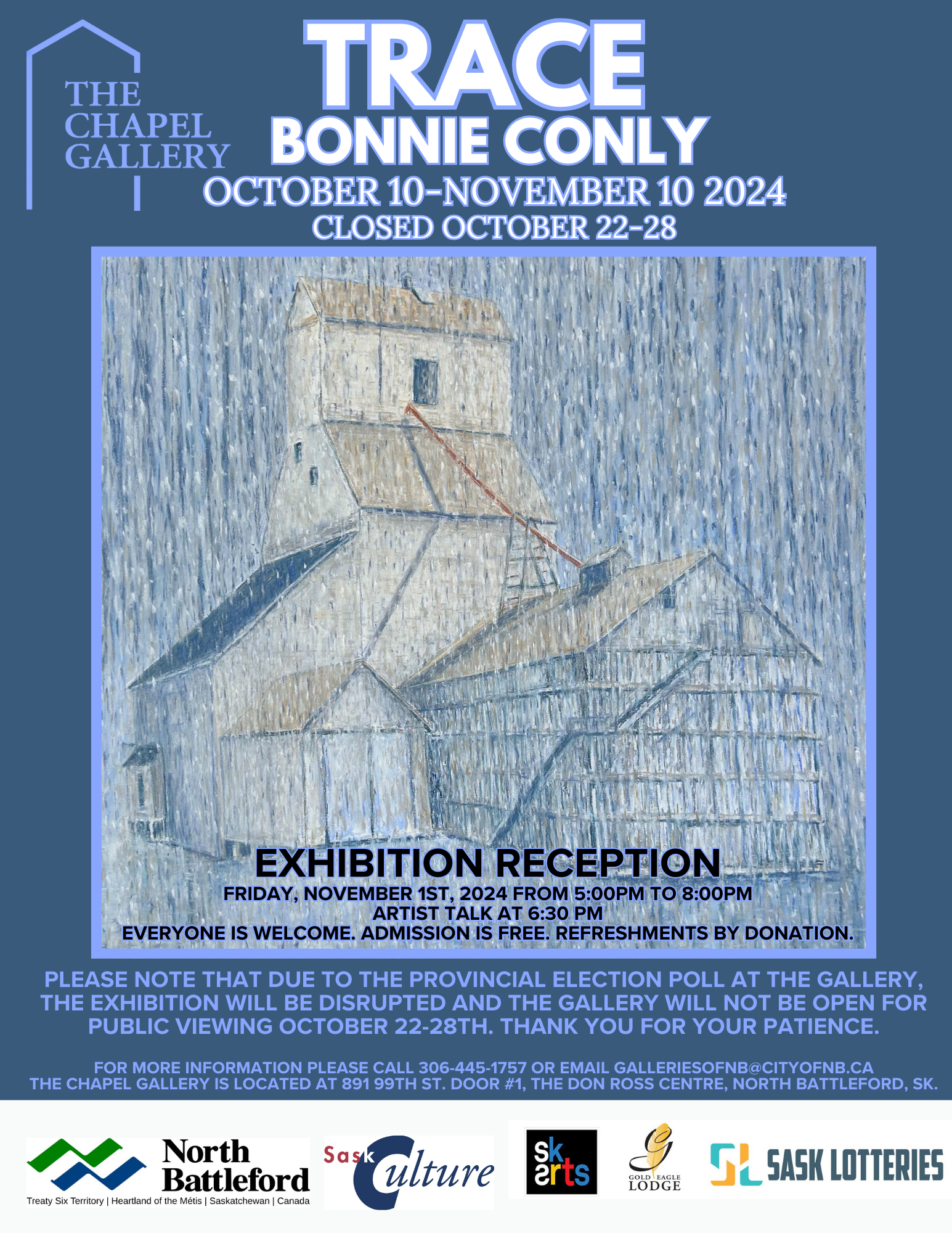
TRACE - Bonnie Conly October 10 - November 10th , 2024
Due to the Provincial Elections there is viewing interruption between October 22-28
My art translates my connection and observations as I move between rural and urban environments. Both natural and constructed elements that define these spaces influence my work. I find that places of quiet engagement and solace are becoming increasingly rare. Thus , they have become sacred to me and have conceptually inspired a need to celebrate them in my art. I believe there is an affective bond between person and place that creates a history, a concious and unconscious engagement where location prompts emotion, experience, and memories. I beilieve this tie to be so strong that history remains even when a place physically changes. It is this element of "trace" that compels my work, merging reality with personal, symbolic, and metaphoric layers.
The exhibition Trace is comprised of drawings and sculptures depicting prairie architecture built to settle Western Canada during the early 20th Century immigration boom, and now mostly in ruins. This work started with a quest to find the locations of 10 historical Saskatchewan water towers that resembled lighthouses, and then expanded to include other architectural structures that are iconic to the Canadian Prairies.
From the sidelines, I witnessed a transition in prairie agricultural practuces and the growth of 'Mega Farms'. Gone are the predictable nine-mile intervals between once sustainable communities. Rural communities are fading like mirages on the horizon.
Economic and cultural shifts have contributed to loss of place and a distinct way of life. Grain elevaors, churches, barns, granaries, and homesteads are collapsing. Wetlands and agressive vegetation are pulling structures to the earth. In-land grain terminals and bin-yards are the new landmarks. The chant 'go big or go home' echoes as I travel familiar roadways searching for the remnants of foundations, soil depressions, historical, and geographical indicators.
I think about abandoned structures as vessels and temporal markers layered with emotions and memories - revealing dreamworlds - conjuring their original physical presence. "The dreamworld of abandoned space is one that is empy of people yet remains crowded by their left-over resonance," and, "Here, the dreamworld is a place of disjunture, of life and death entangled and askew and where the everyday present becomes haunted by the marginal past" (Armstrong, 2010)1
Curiosity compels me to explore abandoned spaces and imagination holds me there. Ephemeral traces linger: a memory, an idea, a knowingness. The experience is nostalgic and somewhat tragic. These abandoned architectural spaces are fragments of lived lives and carry messages about oppression and triumph: hope and despair; melancholy, yearning and loss.
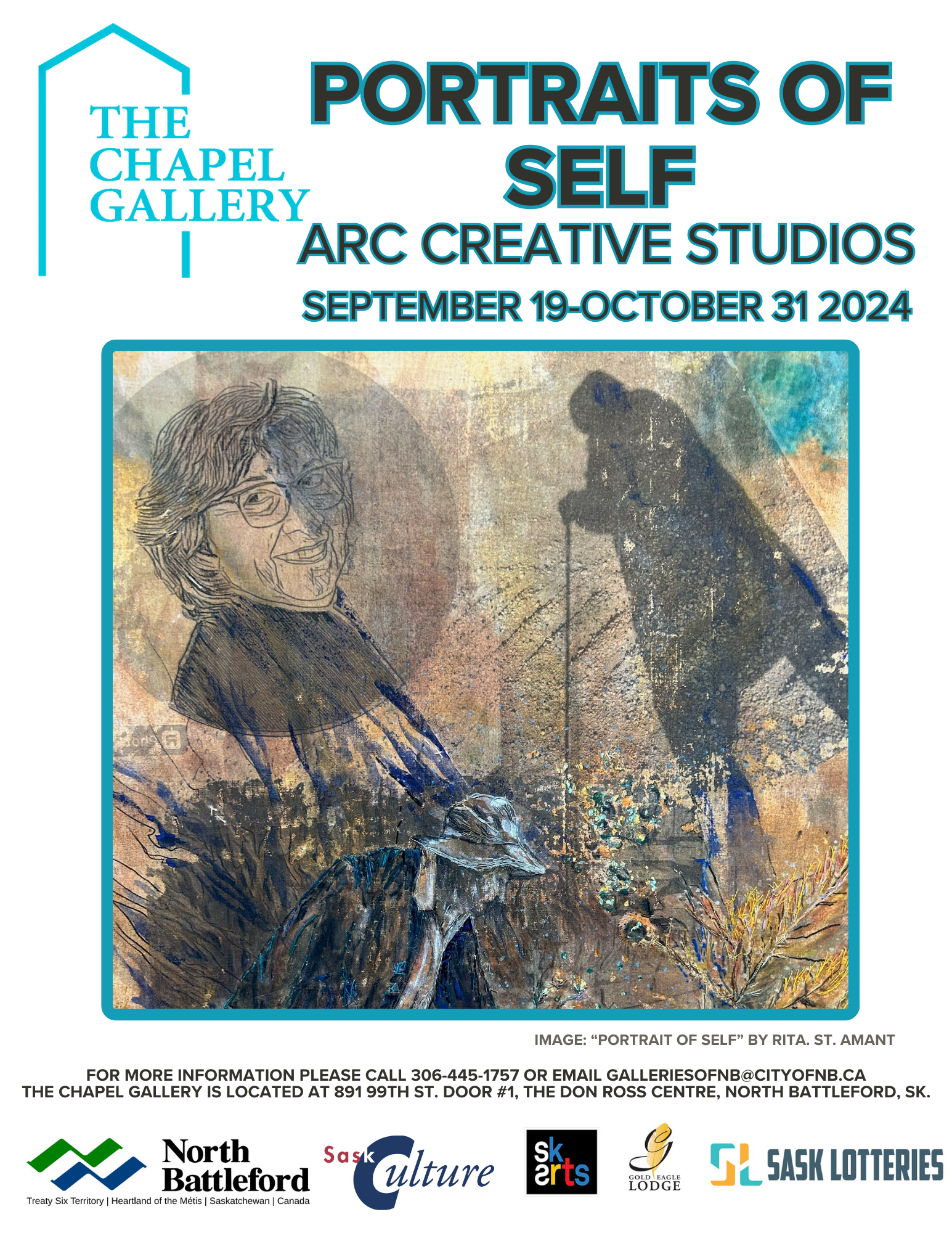
Portraits of Self - ARC - Creative Studios
Portraits of Self: "Portrait" can be many things. Most commonly, a "portrait" is defined as a piece of visual artwork representing a person, usually the face, head and shoulders. "Portrait" is also used more broadly to encompass representation or impression of someone, through any creative discipline. Some of our portraits of self may be literal representations of our physical selves, some are conceptual. In either case, our artwork provides a varied and intimate look at self beyond the physical form.
As artists, the ambition of our pieces in this exhibition is to represent our artistic practices and our ways of processing the world through whatever subject matter we see fit. For many of us, being creative is an integral part of our sense of self. Being artists determines not just our hobbies, careers, the work we make, but how we perceive and interact with the world. These portraits offer a look into our similarities, as much as our differences as artists and humans.
One of the core values of ARC is community collaboration. I invite all of those who view the show to spend time thinking like artists and reflect on not just the artwork, but your own sense of self. What really resonates with you? Why? What might your portrait of self-look like?
- Aleksi Ann, ARC Member
Exhibiting Members: Aleksi Ann, Juanita Aucamp, Kamila Badura, Sherron Burns, Bob Carnahan, Leila Dufresne, Heather Hochbaum, Chris Hodge, Brenda Lamb, Barb O'Neal, Rita St. Amant, Rosemarie Stadnyl, Mariann Taubensee, Celeste Tootoosis, Rochelle Weenie, Savannah Weenie-Pierre.
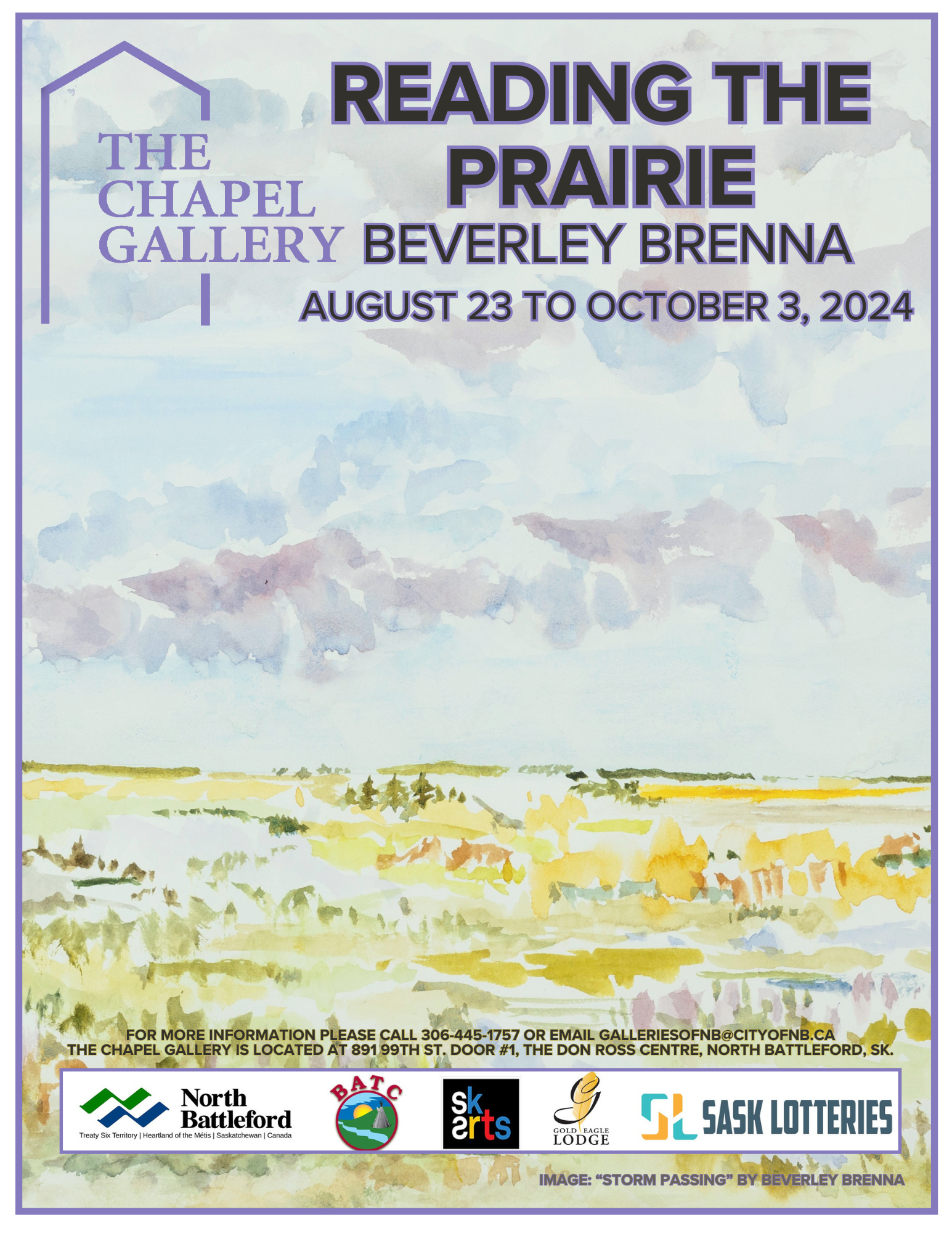
Reading the Prairie - Beverley Brenna
Created in the footsteps of artist Millicent Bardwell, a family friend I observed working in this locale when I was a child, these paintings express apoetic quality of the land that is sometimes lost to viewers. I've spent the better part of two years looking carefully at landscapes in the Battlefords region, and exploring areas north and south of Saskatoon, resulting in a body of paintings that encapsulate both the observation and responsivity to surrounding shapes and colours.
I was writing about the prairie long before I established my practice as a visual artist, and although the two creative fields are significantly connected, I didn't formally make this link until conceptualizing this show. The more I thought about reading the land, the more persistently my previously written poetry called out - until I began to consider the places where image and text converged, and thought about how the poetry might provide audiences with another way to read these paintings and the subjects they represent. The poems selected for the banners included here will hopefully offer viewers the opportunity to independently seek and make connections between art forms.
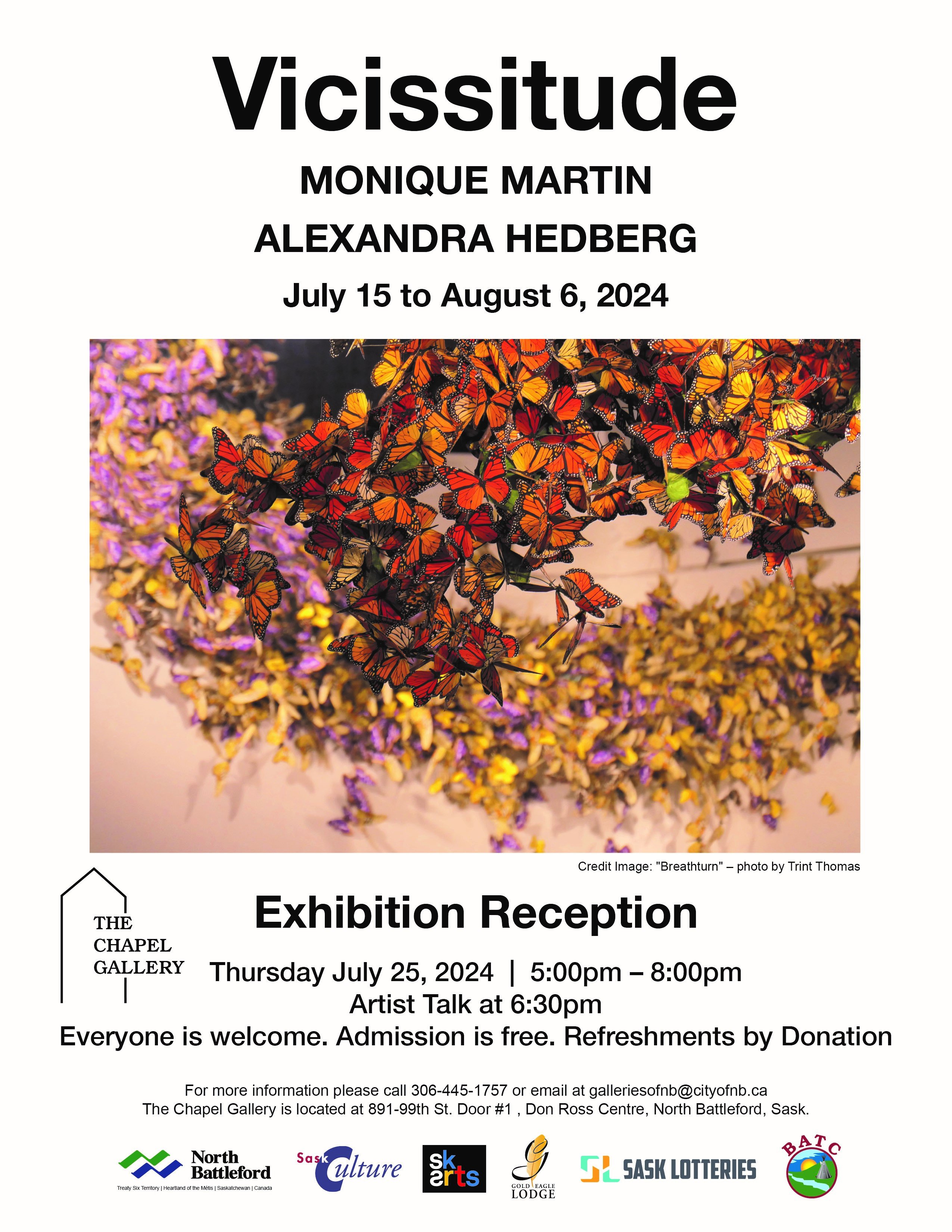
Vicissitude - Monique Martin and Alexandra Hedberg
Vicissitude
noun
plural noun: vicissitudes
a change of circumstance or fortune, typically one that is unwelcome or unpleasant.
Artist Statement
Transformation occurs through deep time when life hangs like a question mark, fragile and always changing. A moment in time can impact this planet, but it can also take years and decades to notice the change. Transformation is a process within human existence and within the ecosystems on the earth that allows us to live in the continuous present as we know we will not be the same person or planet tomorrow that we were today. The arithmetic of life can be looked at as continuous subtraction or as continuous transformation. When parts of our life and the earth run thin like the transparent chrysalis of a butterfly there is room for transformation ,change, growth and movement.
We thought the environment was frozen in time. It is now a slow emergency. Nature measures time in epochs, eras, eons; it is not based on human construct or days of years. Humans trespass without notice on nature's time scale, but have altered deep time. Our trespassing renders a lasting impact, stripping mother earth, leaving her vulnerable and weak. We were complacent thinking we had the answers and believing that tomorrow is always promised. Did we even really try? The eternal seconds of our nascent attempts to address climate change may be too later. The regrets will be carried by the future generations comparing what we could have done with what actually occured.
Time is eternal and everything is gradually covered by the earth.
"Storied Skies"
BOBBI CLACKSON-WALKER
May 25 - July 9th, 2024
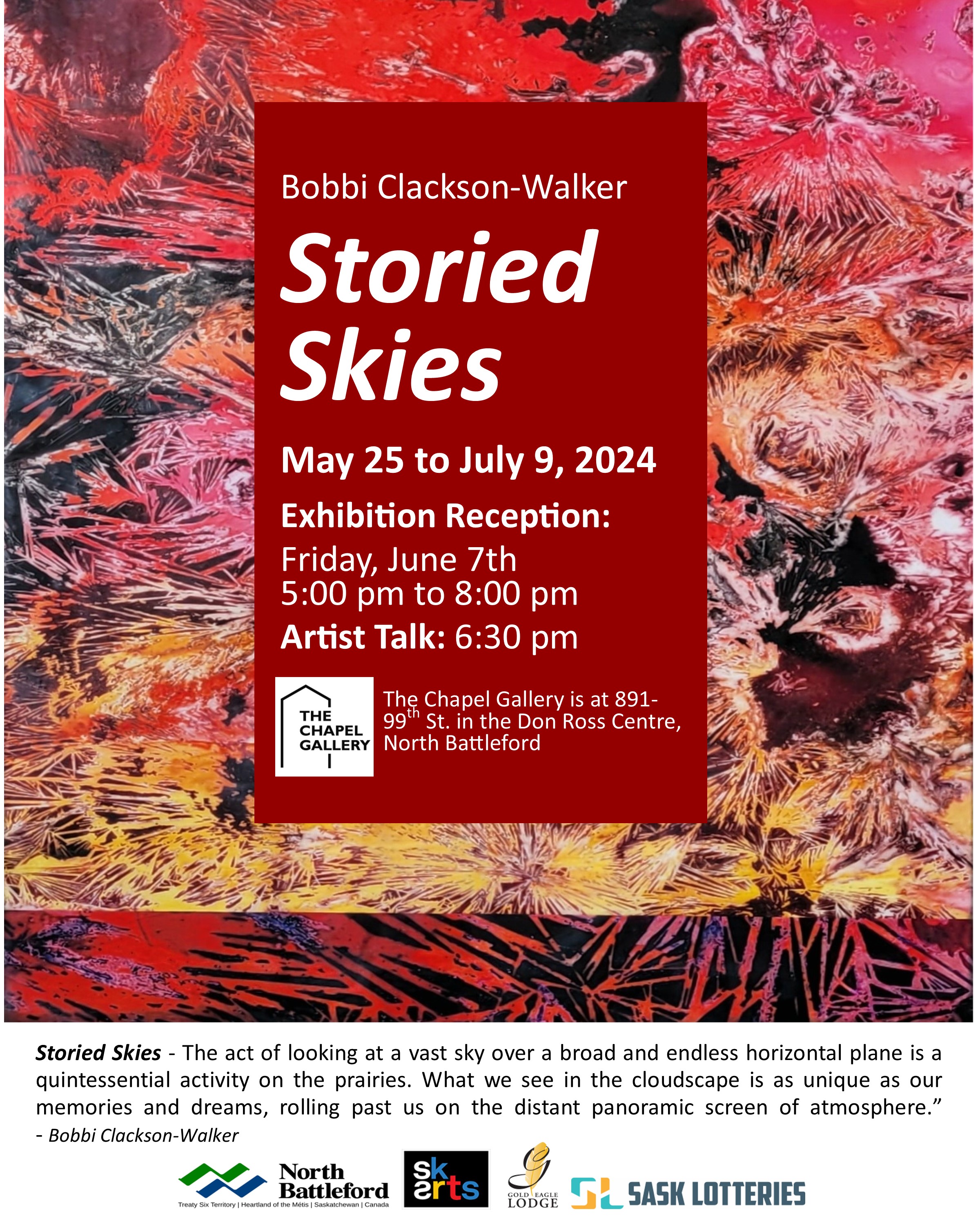
STORIED SKIES - BOBBi CLACKSON-WALKER
The act of looking at a vast expanse of sky over a broad and endless horizontal plane is a quintessential activity of life on the prairies. Since childhood, cloud formations in the broad expanse of sky have fueled my imagination and grounded me with a sense of place. Cloud formations can appear as slow-moving animations or be reminiscent of a personally held memory or experience. They are our memories and musings served up to us on a distant panoramic screen of atmosphere. My lifetime on the prairies has provided me with a rich and visual library of cloudscapes which I called upon in creating the "Storied Skies" exhibition.
Each artwork in the exhibition was created from a salt crystal monoprint that has been hand coloured with watercolour, coloured pencil, indelible ink, and encaustic wax. The process of creating a salt crystal monoprint is multifaceted. It involves growing a salt bloom on paper from a diluted solution of mineral salt. The mineral salt bloom is then dehydrated on the paper and a chemical solution is applied, creating an etched surface or a monoprint of the negative space around the salt bloom pattern. No two salt crystal monoprints are alike, and once the salt crystals have etched the paper, they dissolve and cannot be replicated.
Much of my art practice is motivated by discovery, that is, creating with an attitude of 'what happens when' and looking deeply at the results for clues of how to progress further. The patterns of salt crystal formations captured in the monoprinting process are entirely abstract. To me, that abstracted patterning is reminiscent of appterning I see elsewhere in nature. The "Storied Skies" abstracted monoprints provided me an opportunity to express what I saw as cloudscapes anchored by a broken plain, a landscape so quintessential to the prairies. In truth, the artworks were created as much by examining the salt crystal abstracted patterning, and interpreting my memories in that patterning, as by the processes I employed in rendering them. - Bobbi Clackson-Walker
Facing It
BONNIE GILMOUR and CHARLEY FARRERO
May 18 - July 16th, 2024
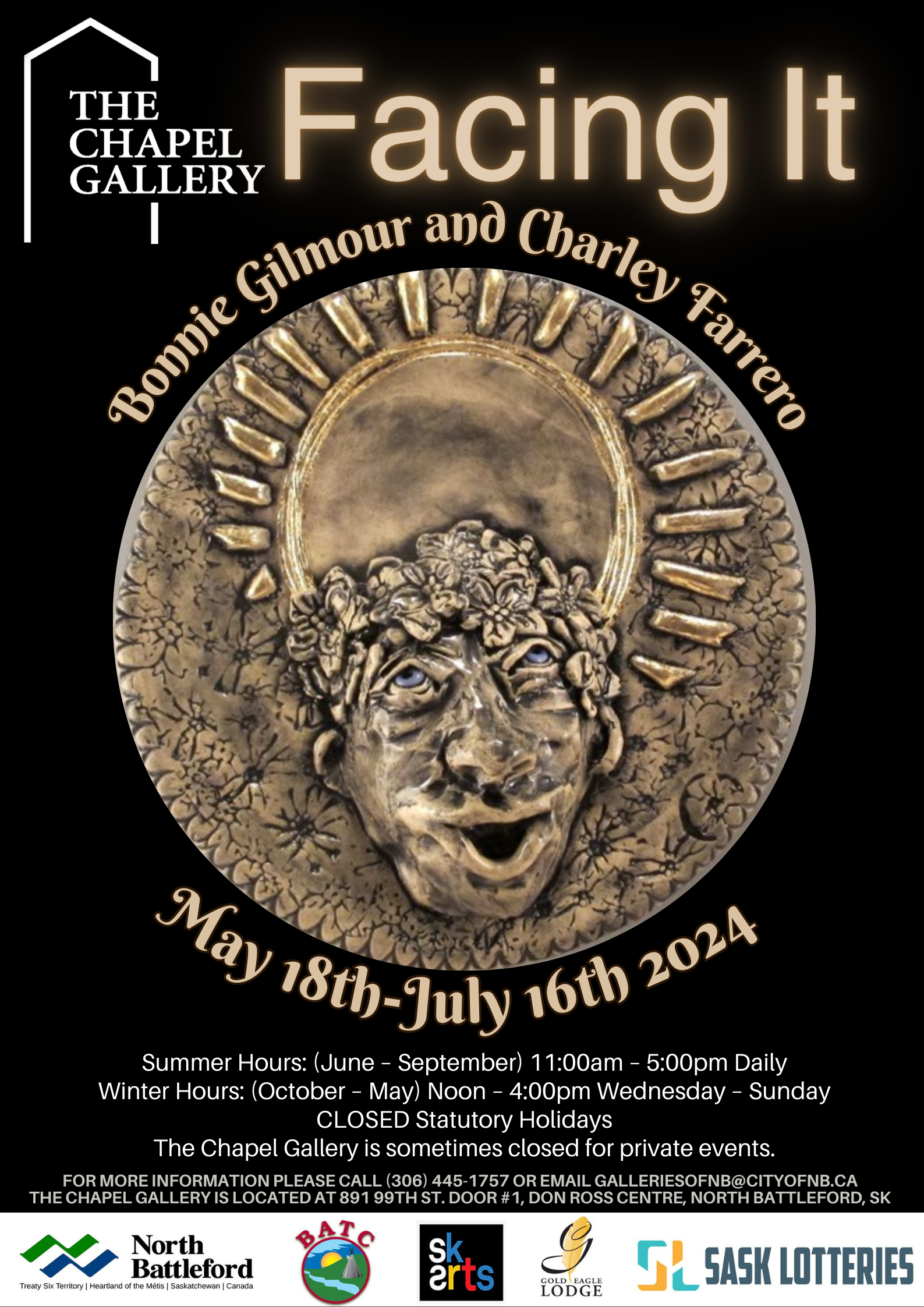
FACING IT
Bonnie Gilmour and Charley Farrero
Together we make, and shape in clay, at our studio day to day. It's what we do , in life and art, Charley and Bonnie are never apart. The winds have blown these artists far. Across the globe, from star to star. Our art's in Chile, Mexico, and France. There are no rules...give clay a chance!
We watch, observe, and learn our world. We form it in clay, then it's unfurled. A case you know, you've seen before, but just can't place, as behind the door. The tableaux-vivant, the story to tell, so much inside, it do look well.
These sculptures speak and evoke emotion, some with content as deep as our ocean. Events of war, and love and home. Food fights of fancy moan. Things we think, then push away, in our hopes for a brighter day.
We are FACING IT; our human condition
With our sculptures.... a ceramic rendition.
Chaos and (Dis) Order - Heather Hochbaum
March 9 - April 21, 2024
Reception Thursday March 21, 2024
6:00pm - 8:30pm - Artist Talk at 7:00pm
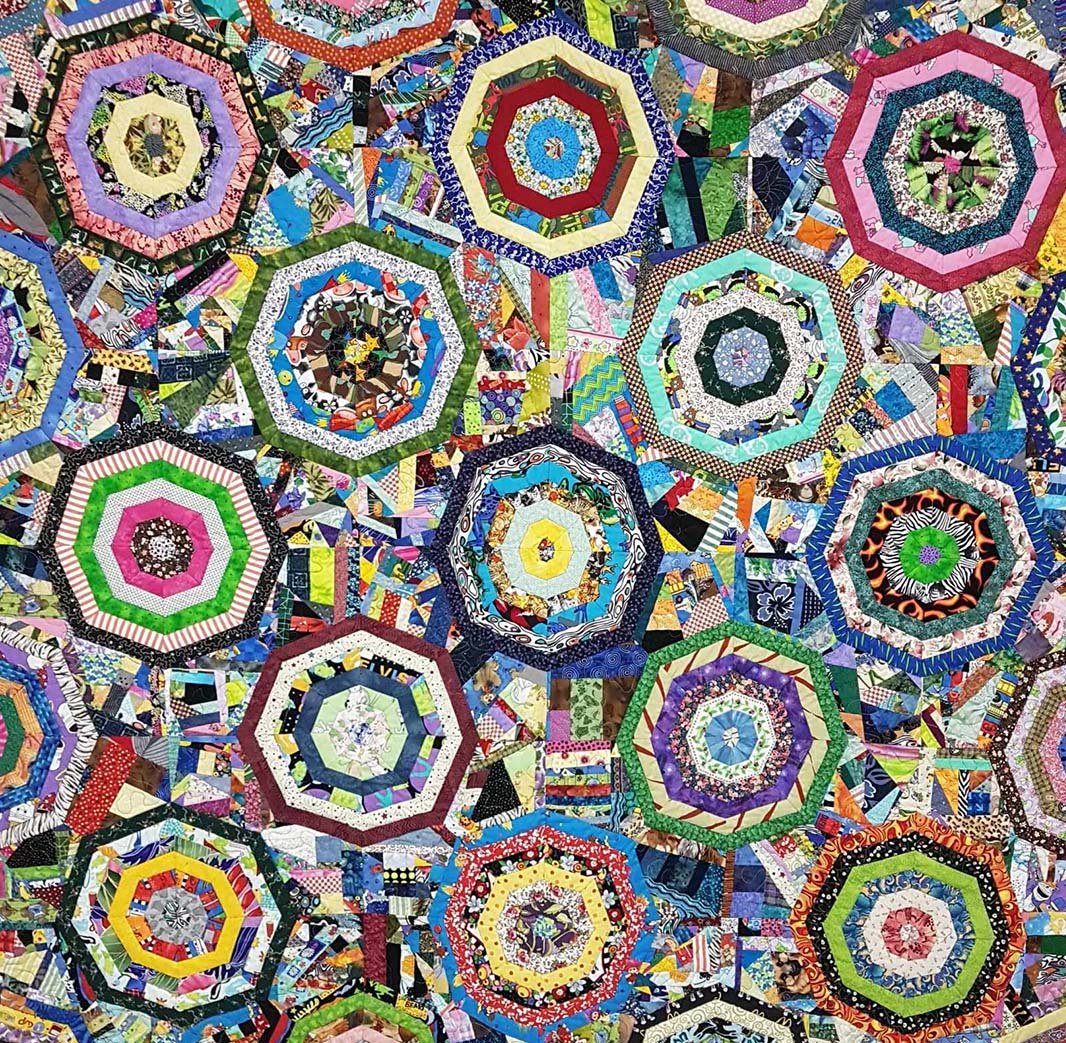
Covid Crazy 1 - Cotton Fabric - 2020 - Heather Hochbaum
Chaos and (Dis) Order
Heather Hochbaum
This show includes 20 artworks and two installations which are mostly quilts and quilted works, along with some mixed media pieces. The best thing one can say about the past few years is that it has been unsettling. Climate change, buried history, wars, unstable politics, and governments, and of course, Covid has created a sense of disorder and a longing for past times.
I have used traditional quilting patterns for most of these worksl "log cabins", "crazy quilts", and "flying geese" to name a few. However, I have used non-traditional settings and colour schemes that give an impression of the frenzy and disorder that I felt during the lockdown to the present. Althought they are bright and colourful, each piece has a darker back story.
I would like to acknowledge the inspiration of Sheila Hicks and C. June Barnes, some of my favourite fiber artists, for the pieces "Sticks and Stones", and "Every Block Has a Story".
Heather Hochbaum - " I am a fiber artist situated in the parkland area of Saskatchewan and I live along the banks of the North Saskatchewan River. I do both traditional quilting and fiber art. My grandmother taught me how to sew, knit, and crochet at a very young age and I have continued this throughout my life. As a self-taught quilter, I don't always follow the rules. I use non-traditional materials, stitching and settings to create "quilts" that can be atypical and novel. I am fascinated with colour, the relationships between colours and how those relationships evoke moods, emotions, and feelings. Colour and texture are strong feature of my work. Recently, I have started to experiement with thread drawing and 3-dimensional pieces.
I have a BA in psychology from Athabasca University and a USCAD Certificate in art and design from the U of S. I have exhibited in several group shows in Saskatchewan including the Saskatchewan Craft Council's "Dimensions 2021-2022" exhibition where I was the recipient of the "Excellence in Quilting" Award. My solo exhibition, "Lady Sings the Blues" showcased in 2015 at The Chapel Gallery in North Battleford and I had another solo exhibition at the Kerrobert Courthouse Gallery in 2017. My quilts are owned by collectors across Canada, the United States, and England. I am a member of the Rivers Edge Quilt Guild and ARC - Creative Studioes, both in North Battleford, Sask. I remain active in the arts locally and throughout the province and I have participated in teh OSAC - Organizations of Saskatchewan Arts Council - Adjudicated Exhibition hosted by Biggar Museum and Art Gallery where my work was a finalist.

Landscape Figures
Chris Hodge
My practice since retirement started with landscape painting, which then turned to abstraction as I absorbed the rich yet understated Saskatchewan scenery. When I became interested in figure work, I found that these experiences and original influences affected my approach.
I prefer an expressionistic style, with bright colours, layers, and diverse linework. As I became more involved with this theme, I found that the shapes began to simplify and abstract, where I began to use only parts of the complete figure.
This is essentially the working method of a landscape artist as they use only those natural elements which relate directly to their piece. Together with the expressionistic method, this has established a way of painting the figure, which I thought represented 'Landscape Figues'.
My final work can be viewed either as a figure or a type of landscape, depending on the preference of the observer. Through this method I have retained my love of both abstract painting and landscapes in this new direction and hopefully I have presented something new and interesting for patrons to view. Chris Hodge 2024.
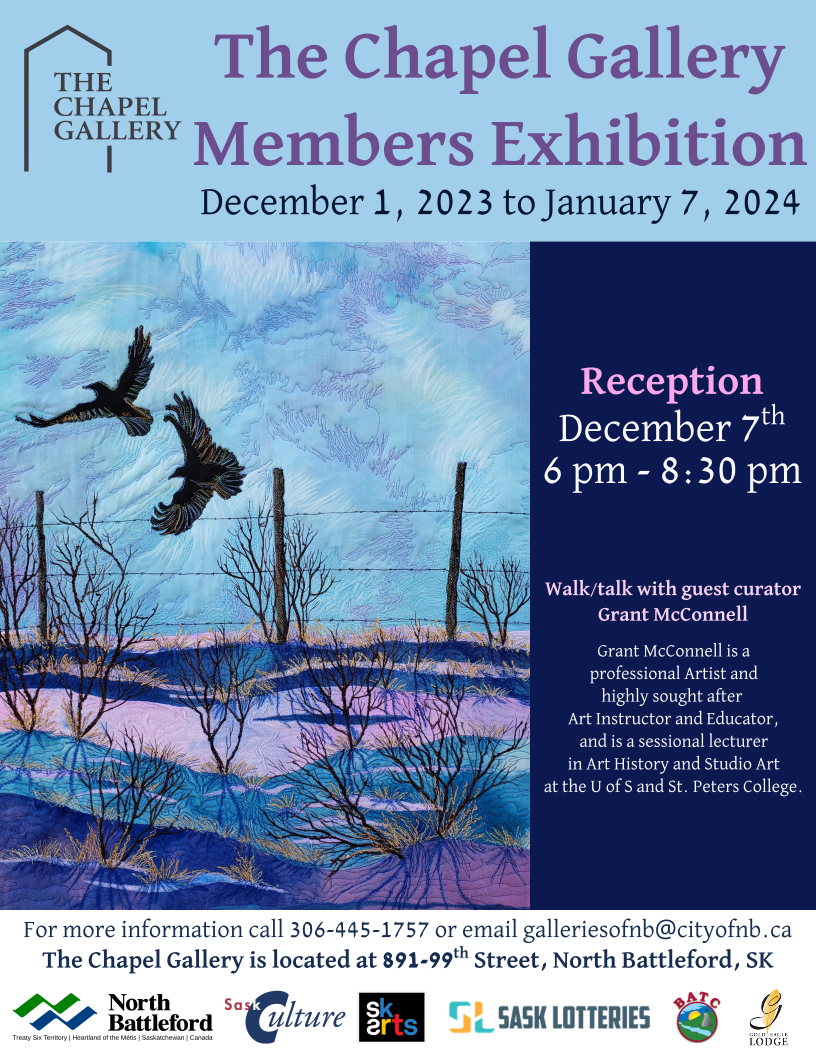
The following Artists are exhibiting work in the 2023 Gallery Members Exhibition:
Rita St. Amant Reg Beardsworth Lorraine Beardsworth
Pam Beaver Gordon Bland Sherron Burns
Evelyn Campbell Paul Constable Faye Erickson
Charley Farrero Evelyn Gardiner Brianne Hager
Nell Haichert Heather Hochbaum Chris Hodge
Lenora Hordos Cindy Hoppe Grace Gerein
Bonnie Gilmour Birgit Lessing Bonny Macnab
Lorraine Voegeli Kevin Quinlan Marilyn Richardson
Joanne Rivers-Wing Rosemarie Stadnyk Linda Hauk
Royal Rogue: POV
Grant McConnell
September 23 - November 12, 2023
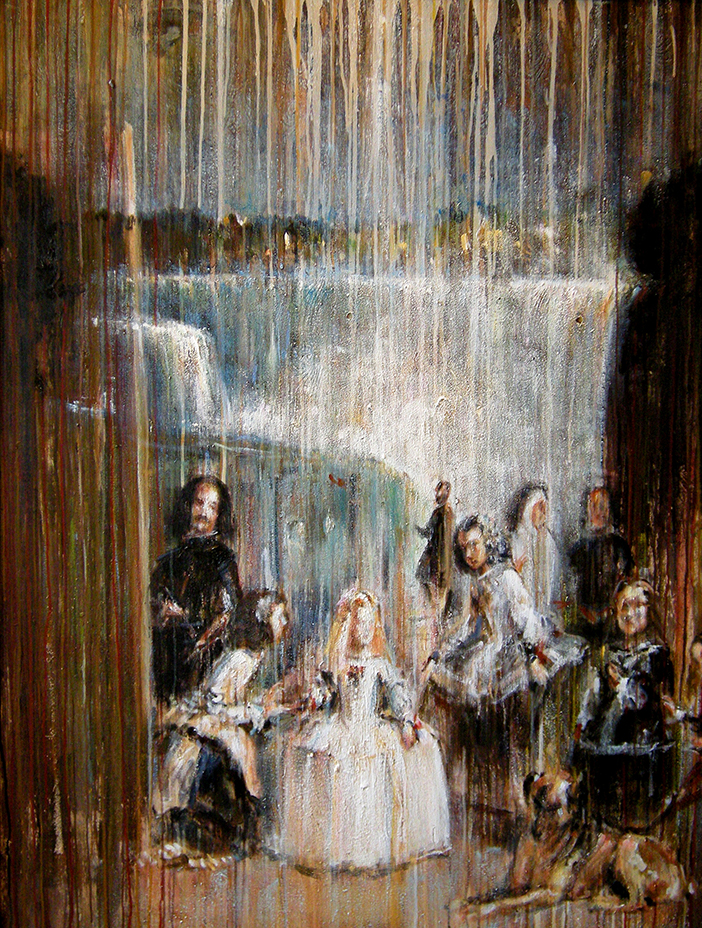
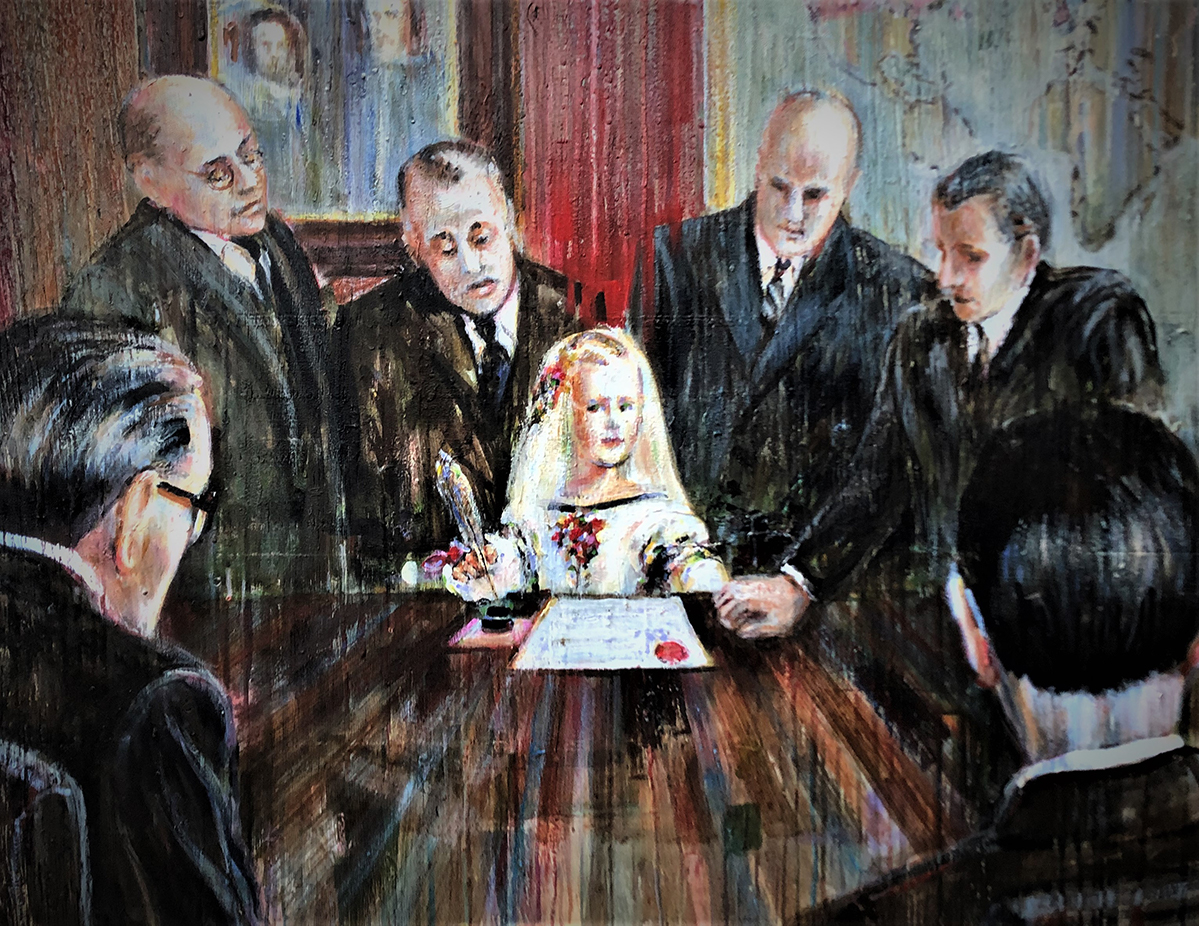
Rogue Royal: POV - Grant McConnell
Art historian, Svetlana Alpers, describes the painting, Las Meninas, by Spanish Baroque painter, Diego Velazquez, as "one of the greatest representations of pictorial representation in all of Western painting". Painted in 1656, Velazquez portrait of the royal Spanish Court, Las Meninas, for centuries now has perplexed viewers and art historians alike, inviting numerous theories and interpretations of this magnificient work. Considered his utmost masterpiece, Las Meninas, with its complex and enigmatic composition, raises questions about pictorial representation and illusion. Velazquez is regarded as one of the most influential artists within Western art history. His explorations of pictorial space and his artistic approaches and principles have been acknowledged as contribution to the evolution of painting in the modern age. Following the Baroque Era, many significant artists throughout art history have paid homage to Velazquez, recognizing his impact on the canon of Western painting. Edouard Manet, whose work was profoundly influenced by Velazquez, described him as "the painter of painters". It is not surprising that this monumental painting and historically - significant artist has captured the imagination of Saskatchewan artist, Grant McConnell, and is the souce of inspiration for this body of work presented in the exhibition, Rogue Royal: POV, featuring paintings and mixed media drawings.
McConnell in his own homage, borrows and alters the players in Las Meninas, not only situating them in settings of his own devise and reimagining new narratives for these royal personages within Canadian folkloric and historical contexts, but transposes them from seventeenth century Baroque sensibilities and places them within the conventions of contemporary painting. McConnell positions Canada, in all of its crude beauty, as a new ground for these royal figures, gone rogue, with a new purpose in the colonies, while his characteristic painting support of raw, fir panel becomes the surface for the narratives to play out on. Layers of paint drip and scumble across the rough wood surfaces of his paintings, creating a woven effect of figure and ground that results in a complex tapestry of imagery, oscillating between figuration and pure abstraction. The drawings in the exhibition are fresh in the rawness, not only allowing the viewer a glimpse into the artist's creative and conceptual process but, in their varied approaches, reference the historical painting lineage that McConnell draws inspiration from, from Velazquez to Piet Mondrian, Francis Bacon, Pablo Picasso, Jasper Johns, and Agnes Martin. McConnell, too, can be described as a painter's painter. The visceral quality of his surfaces interrups the pictorial figuration and illusion, making the materiality of his medium and support always present and part of the engagement in his work.
Throught his painting practice, McConnell has engaged in investigations of subject matter that relates to history, addressing Canadian historical narratives and Western art history in his depictions of still lives, urban and rural landscapes, animal life, and portraiture, as a means of examining memory, representation and notions of nationalism and collective identity. Here McConnell references the great works of Velazquez within new contexts to place contenporary painting in dialogue with its past, while examining representations of Canadian identity and history through fictitious narratives. Former curator of the Mendel Art Gallery, Dan Ring, has suggested that an underlying concern in McConnell's work is to "collapse orders of representation that we use to construct discourses about ourselves, nature and history", in order to create a space where we might examine and questions of triumphal or established narratives. It seems fitting, then for McConnell to feel nautral inclinations towards the 'rogue-ness' of Velazquez, who himself sought to upset established hierarchies of representation in the Baroque Era.
Samskara
Diana Chabros
August 12th - September 17th, 2023
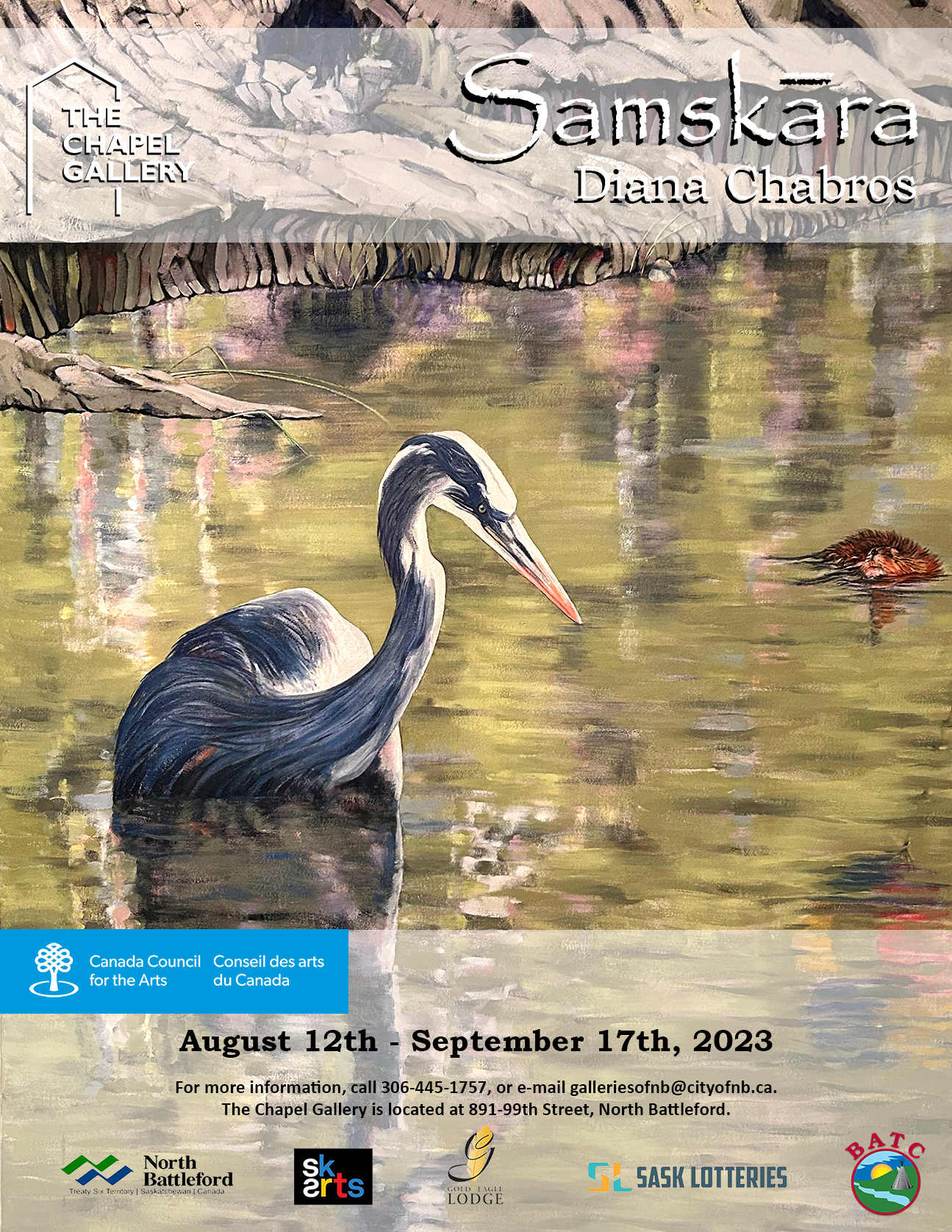
Samskara - Diana Chabros
"The land is made up of the bones of my ancestors..."1
Bones mean a lot to me: my own and those of the land. I broke my spine as a child, so both literally and metaphorically speaking, I know the body is one's first home and I understand what it measn to lose it. This knowledge forms the skeleton of my artistic path, and compels me toward ideas which connect me to the land. The land is also our home and ultimately the receptacle for our remails. I have come to the realization that I will only remain true to my practice by staying true to the land.
I remain fascinated with the visual ele,ents of southwest Saskatchewan and explore energy in its physica, psychic and spiritual forms as a means to understand my interdependent relationship with the land.
Known to biologists, artists, photographers, tourism operators, ranchers and other locals as 'grasslands', and to First Peoples as 'maka tatanka' or 'buffalo-land', the southwest and its natural inhabitants are celebrated for their beauty and resiliency to survive under extremeely harsh weather conditions. Compromised, however, by accelerated human intervention, the lives of these inhabitants, (many of them considered species at risk are compromised to the point that even the soil has become a 'species at risk'.
In my painting practice I use realism to portray actual landmarks along with their non-human inhabitants combined with fictionalized visual narrative. I walk the land with camera, conducting traditional protocol as I go. My artistic process is informed by reviews of historical documents, poetic literature, oral history, my own meditation and dream work, and a specialized dialogue process borrowed from intuitive process painting which allows me to build a working relationships with each painting. Through this process I witness, honour, learn from and care for the land and its resident beings. Through this method of research I discover the transformational currency of these various forms of energy.
The term 'transformational currency' refers to the archetypal cycles of life and death, and the stories that arise. My ongoing studies with First Nation knowledge keepers, including my life partner, as well as the practices of Yoga and Tibetan Buddhist philosophy move me beyond my colonial understanding of the natural world, and is refelcted in my work. For me, these processes, worldviews and my experience of the land transform my subject matter from simple 'landscape' to an exploratory fusion of land, self, and other. My artistic practice is evolving into one of reciprocity and humility.
Inspired by contemporary visual artist Marsha Kennedy, photographers Edward Burtynsky and James Page, and Metis interdisciplinary artists Madonna Hamel, Joseph Naytowhow, and Moe Clark, the act of painting for me yields a visual health record or 'temperature gauge' of the land and its inhabitants. Painting is how I stay in touch with my subject matter while I am away from 'the field'.
Passages
Paula Cooley and Louisa Ferguson
July 7th - August 6th, 2023
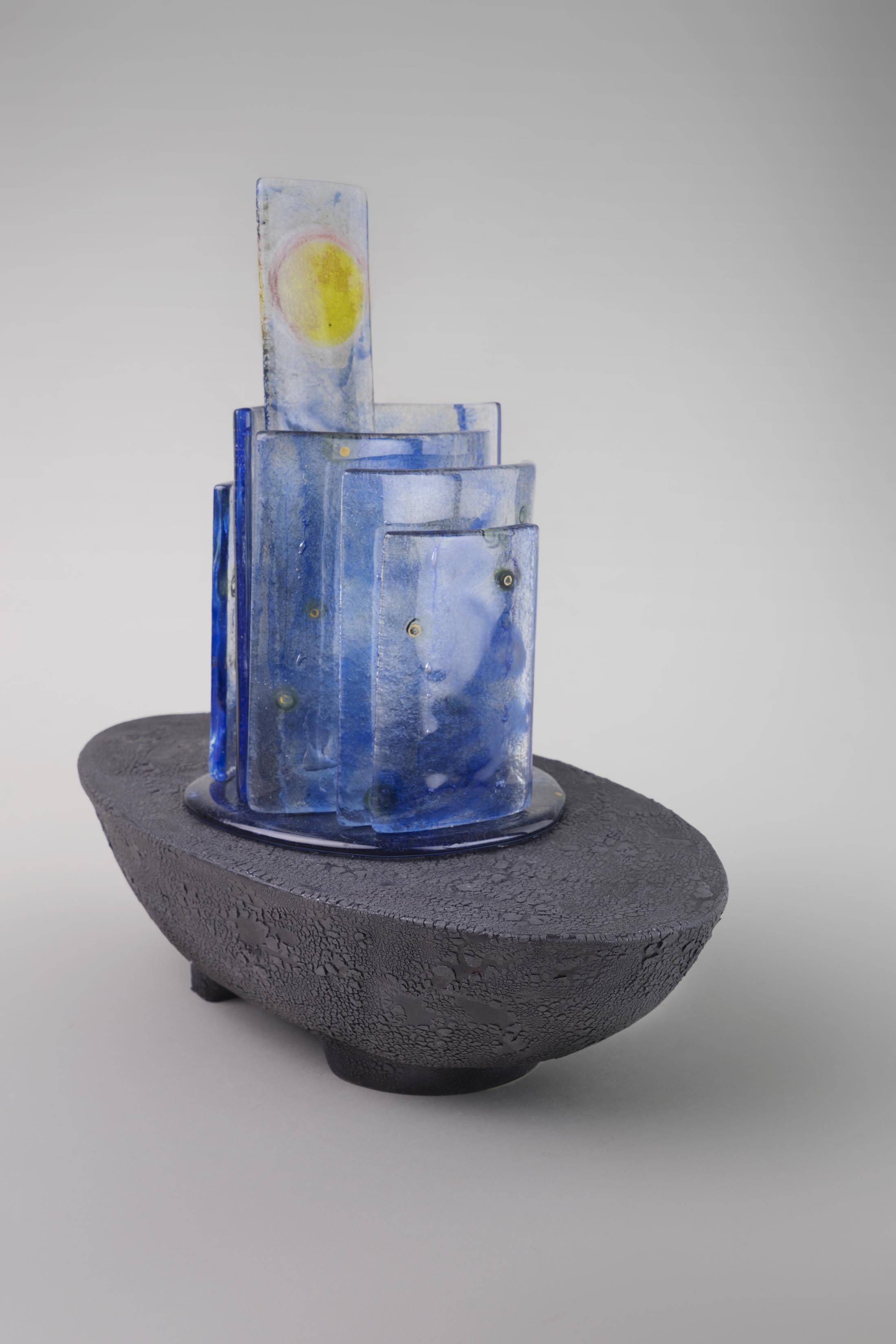
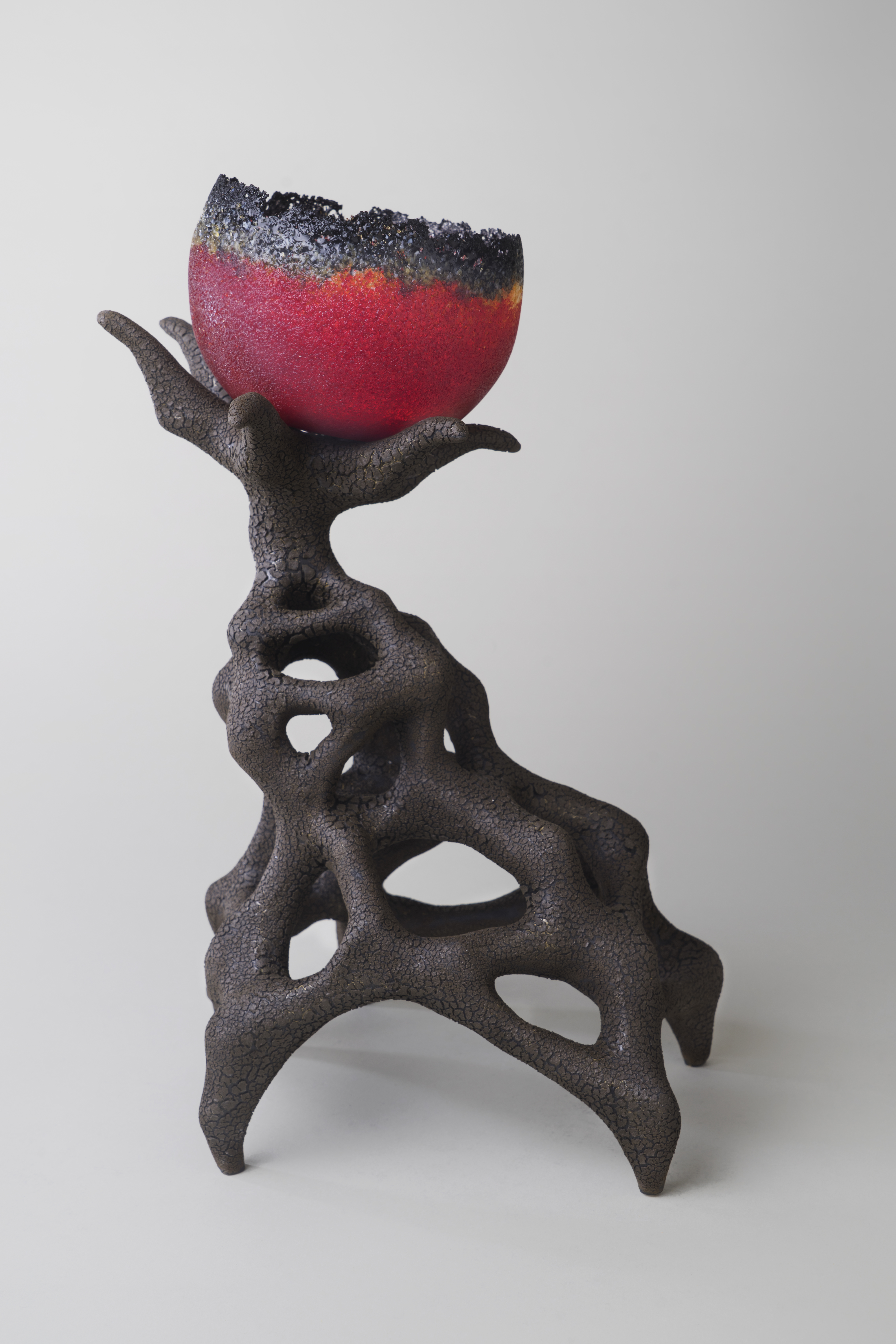
Nocturne Ember and Ash
Clay and Glass by Paula Cooley and Louisa Ferguson
Passages - Paula Cooley and Louisa Ferguson "
Our mixed media exhibition, Passages, grew out of a CARFAC Mentorship we did together in 2015-16. As part of our mentorship, we combined our respective mediums of clay and glass to create several collaborative pieces. The resulting ceramic and glass sculptures whetted our desire to continue to create and exhibit together, providing the impetus of the new work exhibited here with Passages.
We used the iconic boat form as a starting point for both our collaborative and individual works in Passages. The boat form allowed us to explore various interests, be it the formal qualities of light, shadow and negative space or metaphorical journeys through life and time. In some of our pieces the boat is easily recognized while in others the form has been abstracted and evolved into a new and different vessel.
Our process as artists is complementary. We both view the creative practice as dialogue between the artist and the emerging work. We work intuitively, reacting to ideas and forms and then modifying our work accordingly. For Passages, ideas and forms evolved as we handed off segments of sculptures to each other to respond to and build upon. The collaborative process can be difficult. There is always the push and pull of individual purpose, personal artistic vision and subjective meaning, but we both found that there was always an invigorating energy propelling us forward to see what work would ultimately emerge. As and experience, the creation of Passages was a constructive interchange between two artists exploring form, a symbol, and narrative.
The sculptures incorporate a variety of media such as glass, ceramic, metal, and wood. Approximately a third of the sculptures are collaborative, a thrid are works by Cooley, and a third are works by Ferguson
SYMBIOSIS
Ted Uchacz - Oriol Dancer - Ray Keighley - Ellery Russell
Windows Gallery
June 10th - August 16th 2023
